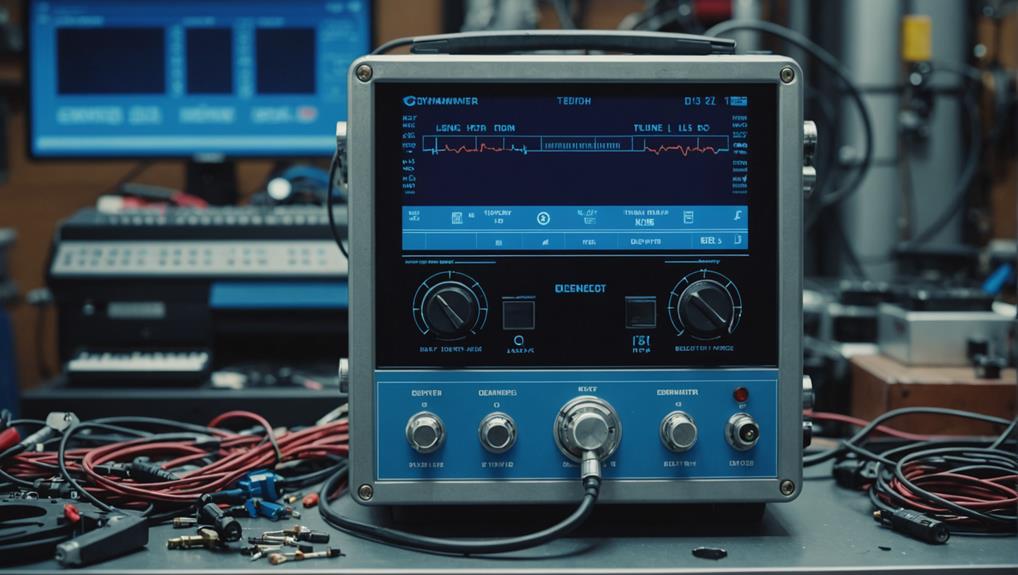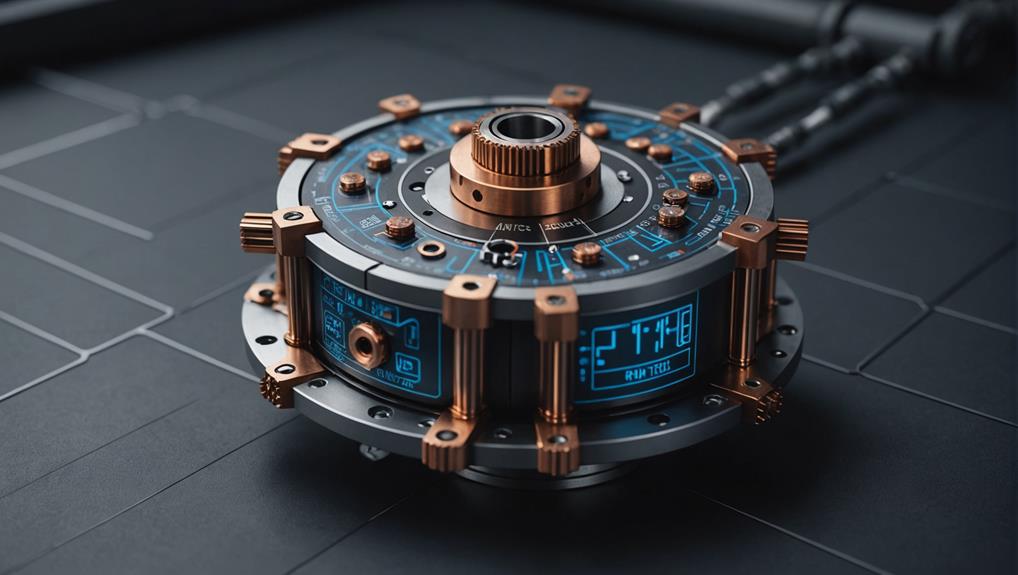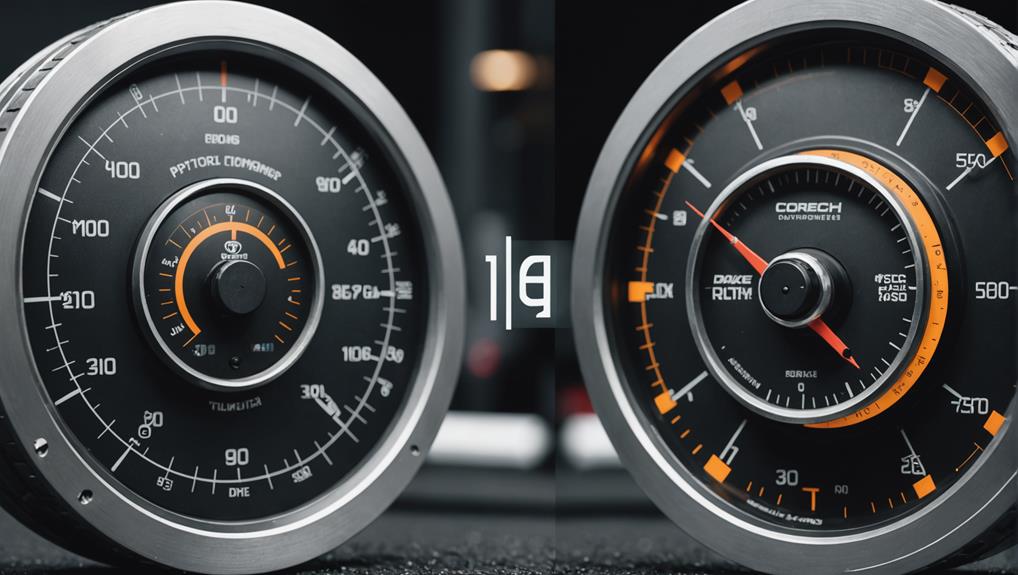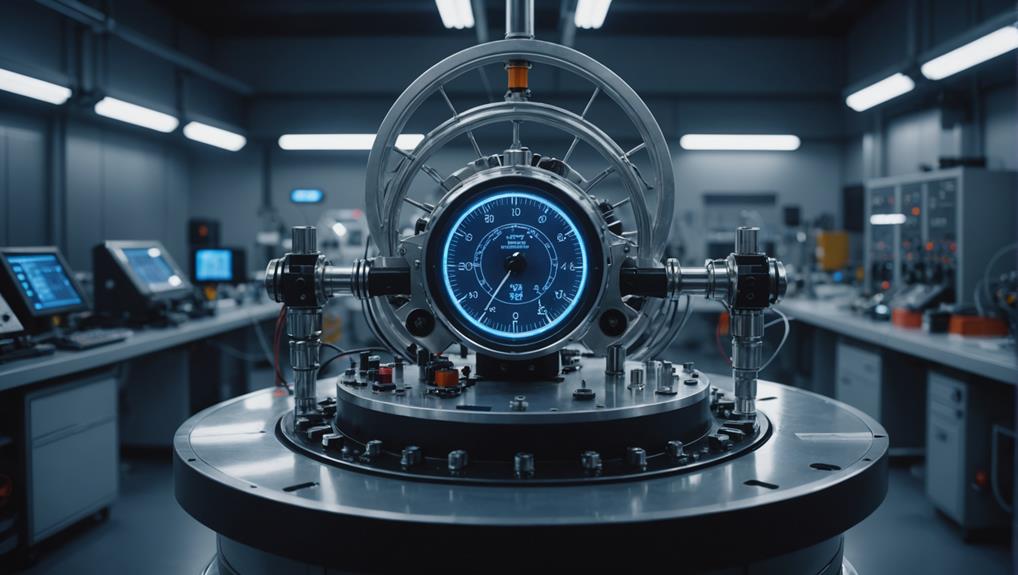
How Dynamometers Enhance Engine Diagnostics and Testing
Necessitating precise measurements, dynamometers unlock the secrets of engine performance, but what else can they reveal about engine diagnostics and testing?
Optimising inertia dynamometers for maximum testing accuracy necessitates a thorough understanding of key design and performance factors.
A well-designed flywheel with optimal weight and rotation is pivotal, as it directly impacts dyno run duration and accuracy. This is particularly crucial for 125cc 2-strokes with 25-35hp, where a clean and consistent belt drive system is essential for reliable dyno readings.
To achieve reliable and accurate power measurement, engineers must carefully consider these factors and ensure precise load simulation.
Additionally, investigating advanced signal processing techniques and software accuracy verification methods can unlock the full potential of inertia dynamometers, providing critical insights into engine performance and beyond.
The design of an inertia dynamometer plays a pivotal role in ensuring accurate and reliable measurements.
A well-designed flywheel is crucial, substantially affecting testing accuracy and load. For instance, a steel flywheel with a diameter of 13 inches and a width of 5 inches, and an inertia of 1.4Kg.M^2, impacts dyno run duration and accuracy.
The weight of the flywheel is essential, as lighter flywheels result in faster acceleration and shorter dyno runs, while heavier flywheels provide more accurate measurements but longer dyno runs.
The belt drive system provides clean and consistent dyno readings, especially for 125cc 2-strokes with 25-35hp.
Engineers can optimise their inertia dynamometers to achieve precise and reliable measurements, ultimately enhancing the testing process, through careful consideration of flywheel design and weight.
Maximising testing accuracy is vital in inertia dynamometer testing, as it directly impacts the reliability of the results.
To achieve accurate power measurement, precise load simulation, and reliable data acquisition, multiple factors must be carefully considered.
These factors include the correct selection of flywheel weight, optimal dyno run duration, and a well-designed dyno with advanced software capabilities.
Accurate power measurement is a critical aspect of inertia dynamometer testing, directly impacting the reliability of the results obtained.
To achieve this, dynamometer testing must be capable of measuring the power output of the device under test with high precision, requiring precise control over the torque and power applied to the dynamometer, allowing for accurate data collection.
Inertia dynamometers typically measure the torque output of the device under test, which is then used to calculate the power output.
To ensure accurate power measurement, it is vital to measure the torque output with high accuracy. High-precision torque transducers and advanced signal processing techniques enable inertia dynamometers to provide reliable and accurate power measurement, allowing users to make informed decisions about the performance of their devices.
Inertia dynamometers' ability to accurately measure power output is substantially enhanced through their capacity to simulate real-world load conditions.
This is achieved by replicating the sensation of acceleration on the road, allowing for precise measurement of engine performance under differing levels of resistance. Simulating road load conditions enables evaluation of engine performance under specific load conditions, facilitating fine-tuning of engines for optimal performance.
The testing range of an inertia dynamometer typically initiates above idle position and progresses to maximum RPM, offering a more realistic simulation of dynamic driving conditions.
This allows for rapid power assessments and diagnosing problems, making them suitable for tasks such as emissions testing and certification. Inertia dynamometers excel at simulating diverse driving conditions, replicating the acceleration and deceleration experienced on the road.
The precision of these measurements is heavily influenced by the drum spool-up speed, which directly affects the accuracy of power measurements. An in-depth insight into engine performance is provided through accurate simulation of road load conditions, ensuring precise measurement and optimisation.
A dynamometer's capacity to acquire reliable data hinges on its ability to accurately capture the subtleties of engine performance, which is why the precision of inertia dynamometers is crucial in maximising testing accuracy factors.
Inertia dynamometers provide precise power measurements through accurate evaluation of acceleration and mass load, simulating the sensation of acceleration on the road.
Loading dynamometers apply resistance to the engine, measuring power through torque and RPM for a more precise representation of real-world conditions.
Evaluating performance under load is crucial for gauging how engines respond to differing levels of resistance, ensuring reliable data acquisition.
Inertia dynamometers are suitable for rapid power evaluations and diagnosing problems, while loading dynamometers excel in delivering accurate and consistent results under diverse load conditions.
Dynamometer accuracy is crucial for fine-tuning engine performance and optimisation, as small variations in data can markedly impact engine calibration and testing outcomes.
Flywheel weight and rotation considerations play a vital role in optimising inertia dynamometers, as the flywheel's mass and rotational speed profoundly impact the accuracy and reliability of test results.
Effective flywheel mass optimization is pivotal to guarantee precise measurements, while flywheel speed regulation is critical to maintain a consistent load profile.
When optimising inertia dynamometers, the mass of the flywheel is a critical factor that requires careful consideration.
The flywheel's mass has a substantial impact on the accuracy and duration of dyno runs. A heavier flywheel provides more accurate measurements, but results in longer dyno runs, whereas a lighter flywheel yields faster acceleration and shorter dyno runs.
Optimising the flywheel mass involves considering the following factors:
A flywheel with an inertia of 1.4Kg.M² and a diameter of 13 inches and width of 5 inches is suitable for measuring the power output of a healthy engine.
The steel flywheel diameter and width of 13 inches and 5 inches, respectively, with an inertia of 1.4Kg.M² is a suitable configuration for measuring 7hp GX160 engines with max revs at 6600rpm.
A flywheel weighing 190 pounds can produce excellent data and graphs when used in a dyno built with a 29-7/8 diameter wheel, 1 inch wide, and weighing 190 pounds.
Inertia dynos measure power output using flywheel weight and rotation, making flywheel weight a vital factor affecting dyno run duration and accuracy.
A suitable flywheel mass guarantees precise measurement of power output, load, and inertia, which are crucial for precise testing and analysis.
Precise speed regulation is crucial in inertia dynamometers, as it directly impacts the accuracy of power output measurements and dyno run duration.
The flywheel's rotational speed plays a critical role in achieving this precision. In an ideal scenario, the flywheel's rotational speed should remain constant, unaffected by the load applied during a dynamometer test.
However, this is not always the case. The weight and rotation of the flywheel substantially influence speed regulation. A heavier flywheel, for instance, provides more accurate measurements but results in longer dyno runs, whereas a lighter flywheel leads to faster acceleration and shorter dyno runs.
On-board data loggers can identify clutch slippage graphs from wheel rotation and motor rpm inputs, allowing adjustments to be made to optimise speed regulation. Engineers can refine their inertia dynamometers to deliver more accurate power output measurements and reliable test results through careful consideration of flywheel weight and rotation.
Optimising belt drive systems is crucial for achieving consistent dyno readings, particularly for 125cc 2-strokes with 25-35hp.
A well-designed belt drive system can provide clean and consistent dyno readings by reducing the inconsistent dyno readings caused by chain drive systems.
Some key considerations for optimising belt drive systems include:
Rubber tooth belt drive systems are preferred over chain drive systems as they reduce vibrations and oscillations, resulting in more accurate and consistent dyno readings.
A 29-7/8 diameter wheel, 1 inch wide, and weighing 190 pounds can be used in a belt drive system to produce excellent data and graphs in inertia dynamometer testing.
The belt drive system's tensioning mechanism must be adjusted to guarantee proper belt tension, which affects the accuracy of dyno readings and prevents belt slippage during testing.
A well-designed belt drive system can help maintain a consistent dyno run duration, typically ranging from 6-7 seconds for a healthy engine, which is fundamental for accurate testing and data analysis.
Inertia dynamometers can provide accurate and consistent dyno readings with an optimised belt drive system, allowing for reliable testing and analysis of engine performance under different loads.
Accurate load simulation is critical in mimicking real-world acceleration times, as it allows engineers to replicate the specific demands of different racing disciplines on an engine's performance.
Dyno testing that mimics real-world acceleration times is crucial for accurate load simulation, as it enables the recreation of actual racing conditions and ensures that test results are reliable and applicable to real-world scenarios.
Inertia dynamometers must be designed to simulate the specific demands of different racing applications, including drag racing, road racing, and other forms of motorsport.
To achieve accurate load simulation, the following considerations are pivotal:
Dyno runs must mimic real-world acceleration times, such as 10 seconds for drag racing or 30 seconds for road racing.
Short duration dyno runs may show HP created by low rotational weight, such as low mass flywheels, which can affect load simulation accuracy.
Long duration pulls show true HP without the effects of low mass flywheels, providing a more realistic load simulation.
Accurate load simulation requires consideration of the specific racing application, including the number of corners and acceleration patterns.
Inertia dyno design must take into account the need to simulate real-world acceleration times to confirm accurate load simulation and reliable test results.
Most inertia dynamometers are designed to test engines under realistic road conditions, which necessitates consideration of various factors, including stop-start acceleration and differing rev ranges, to guarantee accurate testing results.
To achieve this, dyno runs must mimic real-world acceleration times, such as 10 seconds for drag racing or 30 seconds for road racing, allowing for a more thorough grasp of engine performance under diverse operating conditions.
Inertia dynamometers should simulate a range of road conditions, including differing loads and rev ranges, to provide a realistic testing environment.
This enables accurate assessment of engine performance, and optimal engine configuration can be determined. Real-world application and historical context must also be considered when designing inertia dynamometers, taking into account factors such as clutch slip and tire slip considerations.
Mimicking real-world acceleration times and accounting for these factors, inertia dynamometers can provide a more accurate representation of engine performance on the road.
Precise power measurement on an inertia dynamometer relies heavily on mimicking real-world acceleration times, a pivotal aspect often overlooked in engine testing.
Optimising the dynamometer to replicate the specific racing application's acceleration times is essential to achieve accurate power measurement.
Inertia dynamometers should mimic real-world acceleration times, such as 10 seconds for drag racing or 30 seconds for road racing, to guarantee accurate power measurement.
Short duration dyno runs may show horsepower created by low rotational weight, but longer duration pulls show true horsepower without these effects.
Dyno runs should consider the specific racing application to gather accurate data, as racing on circuits with 12 corners requires stop-start acceleration, with revs ranging from 2800 to 6500rpm.
A typical inertia dyno run duration ranges from 6-7 seconds for a healthy engine, and measuring 7hp GX160 engines typically reaches max revs of 6600rpm.
Accurate power measurement on an inertia dynamometer relies on the flywheel weight and rotation, with lighter flywheels resulting in faster acceleration and shorter dyno runs, and heavier flywheels providing more precise measurements but longer dyno runs.
Ensuring the accuracy of software calculations is crucial in achieving reliable test results, particularly in inertia dynamometer testing where precise measurements of torque and horsepower are essential.
To verify software accuracy, several methods can be employed. One approach is to blip the throttle during a dyno run, which should result in a decrease in torque and horsepower at the blipped RPM, thereby testing the software's ability to accurately calculate power output and torque.
Comparing results with other dyno runs or manually calculated values also helps to verify software accuracy. Analyzing dyno run data to identify power peaks and dips can further identify areas where software calculations may be inaccurate or inconsistent.
Regular calibration and updates of dyno software and hardware, coupled with the use of high-quality sensors and data acquisition systems, are indispensable in maintaining accuracy and reducing the risk of errors or inconsistencies in testing results.
Load handling and performance analysis are crucial components of inertia dynamometer testing, enabling accurate evaluation of an engine's power output under diverse load conditions.
Inertia dynamometers accurately measure power output by evaluating the acceleration of a known mass load, simulating the sensation of acceleration on the road.
Loading dynamometers, on the other hand, apply resistance to the engine, measuring power through torque and RPM for a more precise representation of real-world conditions.
Evaluating performance under load is essential for gauging how engines respond to varying levels of resistance, providing insights into power output changes under different conditions.
Inertia dynamometers replicate road load conditions accurately, making them ideal for tasks such as emissions testing and certification.
Loading dynamometers excel in delivering accurate and consistent results, instrumental for fine-tuning engines under different load scenarios.
Each type of dynamometer has its strengths, catering to different application requirements effectively.
Inertia dynamometers are suitable for rapid power evaluations and diagnosing problems, whereas loading dynamometers shine when testing specific load conditions.
Evaluating the environmental impact of vehicles is a critical aspect of inertia dynamometer testing, providing valuable insights into power output changes under different conditions and enabling the development of more eco-friendly engines.
Inertia dynamometers simulate real-world driving conditions, measuring emissions and fuel consumption, which is pivotal for meeting stringent emission norms and reducing environmental pollution.
Testing engines under diverse load conditions, inertia dynamometers provide data on emissions and fuel efficiency, helping to optimise engine performance and reduce its ecological footprint.
The accuracy of inertia dynamometer testing is indispensable for fine-tuning engine performance and optimisation, directly impacting the environmental impact of vehicles and reducing greenhouse gas emissions.
Inertia dynamometers play a paramount role in emission certification of light-duty or heavy-duty automotive engines, ensuring vehicles meet regulatory standards and minimising their environmental impact.
The automotive industry can move towards sustainable energy solutions, reducing its reliance on fossil fuels and mitigating the adverse effects of climate change, through leveraging the capabilities of inertia dynamometers.
Three key aspects of dynamometer testing – precision, realism, and accuracy – are intricately linked, with each playing a pivotal role in evaluating engine performance.
Inertia dynamometers prioritise precision, focusing on acceleration and drum spool-up speed to provide precise power measurements. Conversely, loading dynamometers emphasise realism, replicating actual load conditions and offering insights into engine performance in real-world driving scenarios.
The choice between precision and realism in dynamometer testing depends on the specific application and testing requirements.
Inertia dynamometers excel in rapid power assessments, whereas loading dynamometers shine in testing specific load conditions. To strike a balance between these two aspects, it is necessary to understand the trade-offs:
Precision in inertia dynamometer testing is fundamental for fine-tuning engine performance and optimisation.
Realism in loading dynamometer testing is indispensable for evaluating how engines respond to varying levels of resistance.
The type of dynamometer used influences the accuracy of dynamometer testing.
Inertia dynamometers offer a more extensive portrayal of the torque/power curve.
Loading dynamometers provide a more realistic representation of engine performance under load.
In essence, both precision and realism are crucial in dynamometer testing, and understanding their roles is vital for evaluating engine performance accurately.
While precision and realism are critical components of dynamometer testing, safety protocols and best practices must be prioritised to guarantee a secure testing environment.
This is particularly vital in high-stakes testing applications where the consequences of equipment failure or operator error can be severe.
Safety protocols must be integrated into every stage of the testing process to counterbalance these risks.
A sturdy control system that can detect and respond to potential hazards in real-time must be designed and implemented.
High-precision load cells and strain gauges should be used to verify accurate measurement of test data, and real-time data monitoring enables swift intervention in the event of an irregularity.
Testing should only be conducted under steady-state conditions, with operators following established best practices to minimise the risk of human error.
This includes adhering to strict guidelines and procedures to ensure a secure and reliable testing environment that yields accurate and reliable results.
Optimising Inertia Dynamometers for Maximum Testing Accuracy
At Hyper Power, we understand that the precision of test results relies heavily on the design and configuration of inertia dynamometers. This paper examines the key factors influencing the precision of these dynamometers and provides guidelines for fine-tuning their design.
Several factors contribute to the precision of inertia dynamometer testing, including the flywheel's moment of inertia, rotation speed, and load handling capabilities. Furthermore, the design of the belt drive system, load cell calibration, and data acquisition systems also play vital roles in guaranteeing accurate test results. If you have any questions about our Custom Dyno Solutions, please do not hesitate to contact us.
The flywheel's weight and rotation speed have a profound impact on the precision of inertia dynamometer testing. A heavier flywheel with a higher moment of inertia can absorb more energy, resulting in more accurate measurements. However, increasing the flywheel's weight and rotation speed can also increase the dynamometer's inertia, affecting its ability to accurately mimic real-world acceleration times. Our team at Hyper Power can assist you in finding the optimal solution for your testing needs.
A well-designed belt drive system guarantees consistent and accurate load transmission, reducing the likelihood of errors and inconsistencies in the test results. Our Installation and Setup services ensure that your dynamometer is properly configured for maximum accuracy.
Inertia dynamometers must be able to accurately mimic real-world acceleration times to guarantee realistic test results. This can be achieved by adjusting the flywheel's rotation speed and load handling capabilities to simulate diverse driving scenarios. Our Training and Certification programmes can help you get the most out of your dynamometer.
The load handling capabilities of the dynamometer are vital in guaranteeing accurate test results. The dynamometer must be able to handle the maximum load of the test article while maintaining accurate measurements. Our Technical Support and Maintenance team is available to assist you with any load handling concerns.
Performance analysis software can be used to analyse the test data and provide insights into the test article's performance. Our Software Updates and Upgrades ensure that your software is always up-to-date and capable of providing accurate results.
Inertia dynamometers can be used to test the environmental impact and emissions of internal combustion engines and other rotating machines. The dynamometer must be designed to accommodate the necessary sensors and equipment to measure emissions and environmental impact. Our Diagnostics and Performance Analysis services can help you identify areas for improvement.
There is a trade-off between precision and realism in dynamometer testing. While high-precision testing can provide accurate measurements, it may not accurately reflect real-world conditions. Conversely, realistic testing may sacrifice some precision to better simulate real-world scenarios. Our Rental Services allow you to test your equipment without making a long-term commitment.
Safety protocols and best practices must be followed during dynamometer testing to guarantee the safety of the test personnel and equipment. This includes proper training, equipment maintenance, and adherence to established safety protocols. Our Dynamometer Testing Services are designed to ensure a safe and accurate testing environment.
In summary, fine-tuning inertia dynamometer design and configuration is vital for achieving maximum testing accuracy. By considering the key factors influencing testing accuracy, designers and operators can guarantee reliable and accurate test results. If you require any Accessories and Parts or have questions about our services, please contact Hyper Power.

Necessitating precise measurements, dynamometers unlock the secrets of engine performance, but what else can they reveal about engine diagnostics and testing?

Navigating the complexities of torque measurement requires a deep understanding of the underlying principles and mechanisms to ensure accurate results.

Precise control and optimization of engine performance await, but only for those who unlock the secrets of dynamometer-driven data analysis.

Gaining insight into the differences between inertia and brake dynamometers is crucial for ensuring accurate testing results in various industries.

Tapping into the precise measurement capabilities of dynamometers, uncover the secrets to optimizing fuel efficiency and slashing emissions in the automotive industry.

Witness the importance of rigorous safety protocols and best practices in dynamometer testing to avoid catastrophic failures and ensure accurate results.

Harnessing the nuances of precision measurement is crucial to avoiding costly errors in dynamometer testing, but what are the key factors to consider?

Witness the transformative power of dynamometers in unlocking your vehicle’s hidden performance potential, but only if you know how to harness their precision.